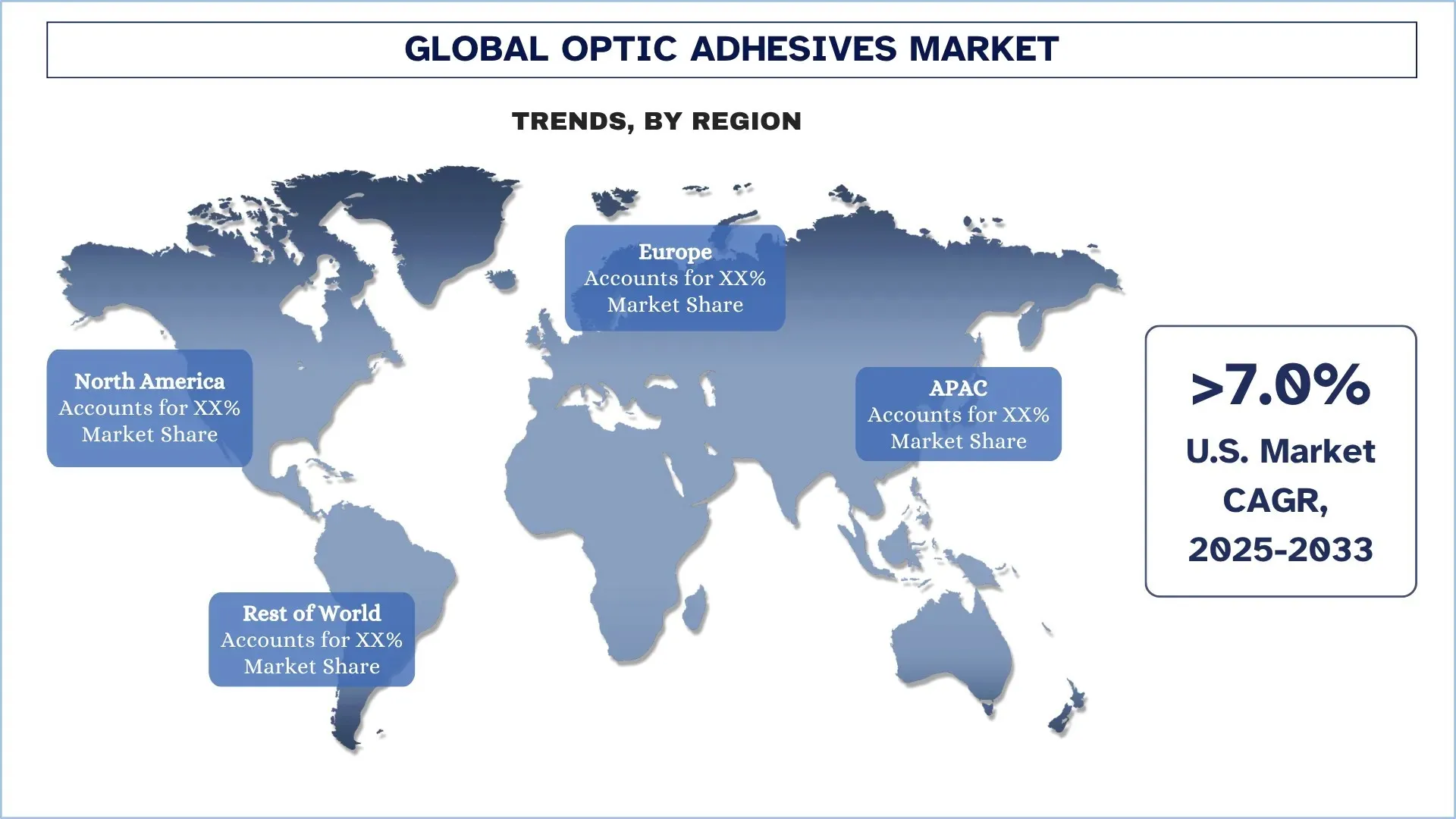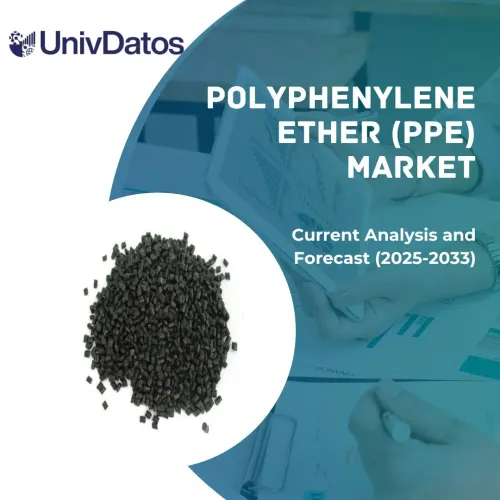- Home
- About Us
- Industry
- Services
- Reading
- Contact Us
Optic Adhesives Market: Current Analysis and Forecast (2025-2033)
Emphasis on Resin Type (Epoxy, Acrylic, Cyanoacrylate, and Silicone); Application (Optical Bonding and Assembly, Lens Bonding Cement, and Fiber Optics), and Region/Country

Global Optic Adhesives Market Size & Forecast
The Global Optic Adhesives Market was valued at USD 1,275.44 million in 2024 and is expected to grow at a CAGR of around 6.41% during the forecast period (2025–2033F), driven by increasing demand for high-performance materials in electronics, automotive, and optics industries. The unique properties of optic adhesives, such as high solubility and optical clarity, make them ideal for glass production, ceramics, and high-tech applications.
Optic Adhesives Market Analysis
The market is being driven by the growing need to use sophisticated optical devices in other industries like telecommunication, automobile, and consumer electronics. Optic adhesives are necessary in connecting the optical components, such as lenses, displays, sensors, among others, with high precision, durability, and resistance to environmental stress factors. Adhesives with higher optical clarity and better refractive index are being developed and are finding new uses in new technology such as augmented reality (AR) and virtual reality (VR). Emerging requirements of lightweight, high-performance materials coupled with the incorporation of automation in the manufacturing of optical materials are further driving up the market. The introduction of green and efficient bonding solutions will help the market achieve its sustainability objectives to sustain its further growth.

Global Optic Adhesives Market Trends
This section discusses the key market trends that are influencing the various segments of the global optic adhesives market, as found by our team of research experts.
Development of UV-Curable Adhesives
The emergence of UV-curable adhesives is one of the prominent trends in the global optic adhesives market, which is characterized by short curing periods, high bond strengths, and minimal environmental effects. These adhesives are cured by exposure to UV light, and thus, they are best suited for applications that require speed and precision. Automobiles, electronics, and medical devices are some of the industries that are now shifting towards using UV-curable adhesives to bond parts like displays, sensors, and lenses. As an example, in 2024, a major electronics company announced a series of wearables based on UV-curable glue to assemble fragile sensors and touchscreens. This innovation not only enhanced efficiency in the manufacture but also increased the toughness of the devices, which were more resistant to wear/ tear. UV-curable adhesives make the process greener and contribute to sustainability because harmful solvents will not be required, and the manufacturing process will be cleaner. This turn to UV-cured solutions is a considerable step towards productivity and environmentally-friendly production in several industries. An example is in July 2025, Permabond launched UV6357, a UV-curing adhesive designed to resist extreme cold. Initially designed as a freezer and refrigerator component, it has strong adhesion to glass, metals, and rigid plastics, such as ABS and PVC. It is important to note that UV6357 is flexible and has 440% elongation and thermal cycling -23 °C to 70 °C, thus it can be utilized in cold storage. It is extremely reactive, meaning that it can be cured with tinted substrates, producing a clear, non-tacky finish that can be used on aesthetic and hygienic design applications.
Optic Adhesives Industry Segmentation
This section provides an analysis of the key trends in each segment of the global optic adhesives market report, along with forecasts at the global, regional, and country levels for 2025-2033.
The Epoxy Segment Dominates the Optic Adhesives Market
Based on resin type, the optic adhesives market is segmented into Epoxy, Acrylic, Cyanoacrylate, and Silicone. In 2024, the Epoxy segment is expected to dominate the market and maintain its leadership throughout the forecast period. Epoxy adhesives are also popular because of their good bonding properties, durability, and ability to withstand environmental stress factors, and therefore, they are more suitable in optical applications. These adhesives perform better when it comes to high-level production processes, namely optical lens production, display production, and sensor production. The segment is largely fueled by the rising demands of high-performance optical devices in various sectors, including telecommunications, automotive, and consumer electronics. Also, the development of epoxy adhesives with better optical clarity and higher refractive index is driving their use in new technologies such as augmented reality (AR) and virtual reality (VR). Epoxy bonding adhesives are gaining more market share due to the increased demand for energy-saving and more sustainable bonding solutions.
The Optical Bonding and Assembly Category held the Largest Market Share in the Optic Adhesives Market.
Based on applications, the optic adhesives market is segmented into Optical Bonding and Assembly, Lens Bonding Cement, and Fiber Optics. In 2024, the Optical Bonding and Assembly segment is expected to hold the dominant share and continue leading throughout the forecast period. Optical bonding plays a vital role in the high clarity and durability of optical devices and is therefore important in displays, touchscreens, and optical lenses. This segment is growing due to the increasing demand for high-definition displays in consumer electronics, automotive, and industry. Advanced bonding solutions are also purchased by large-scale manufacturers in the electronics and automotive industries to enhance performance and reliability. The trend towards thinner, lighter devices and the demand for increased optical clarity are continuing to drive the use of optical adhesives in optical bonding and assembly. These sorts of innovations are expected to extend the product life and high-quality optics.
North America Dominated the Global Optic Adhesives Market
North America is leading the optic adhesives market at present and is projected to continue leading the market during the forecast period. The region enjoys close proximity to major players in the electronics, automotive, and telecommunications sectors, which are the main sources of demand for high-quality adhesives to be used in optical bonding and assembly. The U.S. and Canada are leading in the field of technological innovations, specifically in the creation of augmented reality (AR), virtual reality (VR), and enhanced display systems, which demand accurate and long-lasting adhesive designs. Also, the strong R&D of the region, as well as the high degree of innovation of adhesive materials, contribute to the further development of the market. The government programs related to sustainability and energy efficiency only contribute to the use of high-end optic adhesives even faster. The established manufacturing base in North America, coupled with the presence of major world players in the industry, means that the region will remain at the forefront of the global optic adhesives industry.
U.S. held a dominant Share of the North America Optic Adhesives Market in 2024
The US market in optic adhesives is growing steadily, due to the rapid development of advanced electronics, the automobile, and aerospace industries. The increasing demand for high-performance adhesives in optics and the requirement for significantly durable materials in precision manufacturing are some of the key drivers. There is also an increasing number of eco-friendly adhesive solutions being developed in the U.S., which helps in the development of sustainable production methods. Moreover, high costs of renewable energy sources, such as the manufacture of electric vehicles, are increasing the use of optic adhesives, especially in battery technologies and superior electronic systems. The emphasis that the country has laid on the aspect of innovation and technological development would guarantee the future expansion of the market.

Optic Adhesives Industry Competitive Landscape
The global optic adhesives market is competitive, with several global and international market players. The key players are adopting different growth strategies to enhance their market presence, such as partnerships, agreements, collaborations, new product launches, geographical expansions, and mergers and acquisitions.
Top Optic Adhesives Companies
Some of the major players in the market are Henkel AG & Co. KGaA, Dymax, DELO Industrial Adhesives, 3M, H.B. Fuller Company, Shin-Etsu Chemical Co., Ltd., Master Bond Inc., Norland Products Inc., Dow, and DuPont.
Recent Developments in the Optic Adhesives Market
In 2025, DELO launched two new adhesive products, DUALBOND SJ and PHOTOBOND FB, designed to bond larger camera sensors and lenses for improved performance and thermal stability. These adhesives provide fast, light-curing fixation for precise alignment and can also be heat-cured for full strength, even in applications with narrow bonding gaps or shadowed areas
In March 2022, Dymax Corporation made an announcement that it is rebranding its Oligomers & Coatings business as Bomar Specialties LLC.
Global Optic Adhesives Market Report Coverage
Details | |
Base year | 2024 |
Forecast period | 2025-2033 |
Growth momentum | Accelerate at a CAGR of 6.41% |
Market size 2024 | USD 1,275.44 Million |
Regional analysis | North America, Europe, APAC, Rest of the World |
Major contributing region | Asia Pacific is expected to dominate the market during the forecast period. |
Key countries covered | U.S., Canada, Germany, U.K., Spain, Italy, France, China, Japan, and India |
Companies profiled | Henkel AG & Co. KGaA, Dymax, DELO Industrial Adhesives, 3M, H.B. Fuller Company, Shin-Etsu Chemical Co., Ltd., Master Bond Inc., Norland Products Inc., Dow, and DuPont |
Report Scope | Market Trends, Drivers, and Restraints; Revenue Estimation and Forecast; Segmentation Analysis; Demand and Supply Side Analysis; Competitive Landscape; Company Profiling |
Segments Covered | By Resin Type; By Application; By Region/Country |
Reasons to Buy Optic Adhesives Market Report:
The study includes market sizing and forecasting analysis confirmed by authenticated key industry experts.
The report briefly reviews overall industry performance at a glance.
The report covers an in-depth analysis of prominent industry peers, primarily focusing on key business financials, type portfolios, expansion strategies, and recent developments.
Detailed examination of drivers, restraints, key trends, and opportunities prevailing in the industry.
The study comprehensively covers the market across different segments.
Deep dive regional-level analysis of the industry.
Customization Options:
The global optic adhesives market can further be customized as per the requirements or any other market segment. Besides this, UnivDatos understands that you may have your own business needs; hence, feel free to contact us to get a report that completely suits your requirements.
Table of Content
Research Methodology for the Global Optic Adhesives Market Analysis (2023-2033)
We analyzed the historical market, estimated the current market, and forecasted the future market of the global optic adhesives market to assess its application in major regions worldwide. We conducted exhaustive secondary research to gather historical market data and estimate the current market size. To validate these insights, we carefully reviewed numerous findings and assumptions. Additionally, we conducted in-depth primary interviews with industry experts across the optic adhesives value chain. After validating market figures through these interviews, we used both top-down and bottom-up approaches to forecast the overall market size. We then employed market breakdown and data triangulation methods to estimate and analyze the market size of industry segments and sub-segments.
Market Engineering
We employed the data triangulation technique to finalize the overall market estimation and derive precise statistical numbers for each segment and sub-segment of the global optic adhesives market. We split the data into several segments and sub-segments by analyzing various parameters and trends, including resin type, application, and regions within the global optic adhesives market.
The Main Objective of the Global Optic Adhesives Market Study
The study identifies current and future trends in the global optic adhesives market, providing strategic insights for investors. It highlights regional market attractiveness, enabling industry participants to tap into untapped markets and gain a first-mover advantage. Other quantitative goals of the studies include:
Market Size Analysis: Assess the current market size and forecast the market size of the global optic adhesives market and its segments in terms of value (USD).
Optic Adhesives Market Segmentation: Segments in the study include areas of resin type, application, and regions.
Regulatory Framework & Value Chain Analysis: Examine the regulatory framework, value chain, customer behavior, and competitive landscape of the optic adhesives industry.
Regional Analysis: Conduct a detailed regional analysis for key areas such as Asia Pacific, Europe, North America, and the Rest of the World.
Company Profiles & Growth Strategies: Company profiles of the optic adhesives market and the growth strategies adopted by the market players to sustain the fast-growing market.
Frequently Asked Questions FAQs
Q1: What is the global optic adhesives current market size and its growth potential?
The global optic adhesives market was valued at USD 1,275.44 million in 2024 and is expected to grow at a CAGR of 6.41% during the forecast period (2025-2033).
Q2: Which segment has the largest share of the global optic adhesives market by resin type?
The Epoxy segment is expected to dominate the market and maintain its leadership throughout the forecast period. Epoxy adhesives are also popular due to their excellent bonding properties, durability, and ability to withstand environmental stress factors.
Q3: What are the driving factors for the growth of the global optic adhesives market?
• Advancements in Display Technologies
• Miniaturization of Electronic Devices
• Expansion of Optical Communication Networks
Q4: What are the emerging technologies and trends in the global optic adhesives market?
• Development of UV-Curable Adhesives
• Shift Towards Eco-Friendly Formulations
Q5: What are the key challenges in the global optic adhesives market?
• Stringent Performance Requirements
• High Production Costs
Q6: Which region dominates the global optic adhesives market?
North America is leading the optic adhesives market at present and is projected to continue leading the market during the forecast period. The region enjoys proximity to major players in the electronics, automotive, and telecommunications sectors, which are the primary sources of demand for high-quality adhesives used in optical bonding and assembly.
Q7: Who are the key players in the global optic adhesives market?
Some of the key companies include:
• Henkel AG & Co. KGaA
• Dymax
• DELO Industrial Adhesives
• 3M
• H.B. Fuller Company
• Shin-Etsu Chemical Co., Ltd.
• Master Bond Inc.
• Norland Products Inc.
• Dow
• DuPont
Q8: What product-design strategies are manufacturers adopting to enhance optic adhesives performance and reliability?
• Enhanced Bonding Strength: Use of advanced polymer formulations to increase bonding strength, durability, and resistance to environmental factors.
• Improved Optical Clarity: Development of high-performance adhesives that ensure superior transparency and minimal distortion, ideal for glass and ceramics applications.
• Thermal Stability: Integration of heat-resistant properties to maintain adhesive performance in high-temperature environments, especially in electronics and automotive industries.
Q9: How are sustainability and regulatory compliance influencing optic adhesives R&D investments?
• Eco-Friendly Materials: Manufacturers are focusing on using non-toxic, biodegradable, and recyclable materials to meet growing demand for sustainable products.
• Low-VOC and Low-Solvent Formulations: Development of optic adhesives with minimal volatile organic compounds (VOCs) to comply with environmental regulations and reduce harmful emissions.
• Energy-Efficient Production: Adoption of energy-efficient manufacturing processes to minimize the carbon footprint during adhesive production.
Related Reports
Customers who bought this item also bought










